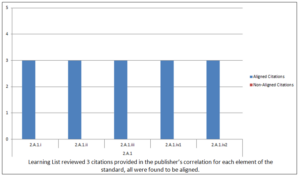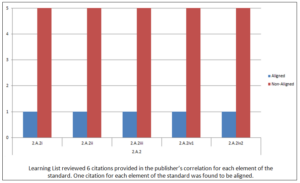If you’ve concluded your Beginning of Year (BOY) assessments, then you’re probably planning RtI for struggling students. When selecting instructional materials for intervention support, these two questions are critical to your students’ success:
- Is the material aligned to the standards students are struggling with?
- Does the instructional material provide sufficient practice for students to master those skills?
Imagine that your assessments show that a 2nd grade student needs help decoding multiple syllabic words (a) in context and (b) independent of context by applying common letter sound correspondences.
The table below shows a popular intervention material’s alignment to the Elements of the Standard that addresses decoding words in context. The material is aligned to each Element of the Standard; in fact, all 3 of the citations Learning List reviewed* were aligned to each Element.
Standard 2.A.1: Decoding words in context:

In contrast, the table below shows the material’s alignment to the Elements of the Standard that addresses decoding words independent of context. One of the citations Learning List reviewed was aligned to each Element of the Standard, but five other citations reviewed were not aligned.
Standard 2.A.2: Decoding words independent of context:

While the instructional material is aligned to both of the standards the student is struggling with, this material would provide only one opportunity for the student to learn/practice each Element of the second standard, decoding multisyllabic words independent of context.
Some level of repetition is typically required for students to understand, internalize, and master content and skills. If this is an adaptive material, this material’s single “aligned” citation may not be instructionally sufficient to help the student “master” decoding multisyllabic words independent of context.
If this were your student, you would be advised to look for a different material that contains more citations aligned to each Element of these two standards, or use the reviewer’s comments in the alignment report to adjust instruction to match the full intent of the standard.
Learning List’s alignment reports make it easy to identify materials that are aligned to the standard your students are struggling with and help you determine whether the material provides sufficient practice for your students to master those standards.
*If the publisher’s correlation lists fewer than three citations as aligned to a standard, Learning List’s subject matter experts review all of the citations listed. If the publisher’s correlation cites more than three citations as being aligned to a standard, Learning List employs a “spot check” verification methodology – at least three and up to eight citations are reviewed for alignment to the standard. If teachers want to use a citation that Learning List has not reviewed, they would be advised to check the alignment of the citation themselves. However, Learning List’s alignment report serves as a guide as to how likely it is that any additional citation would be aligned to that standard.
